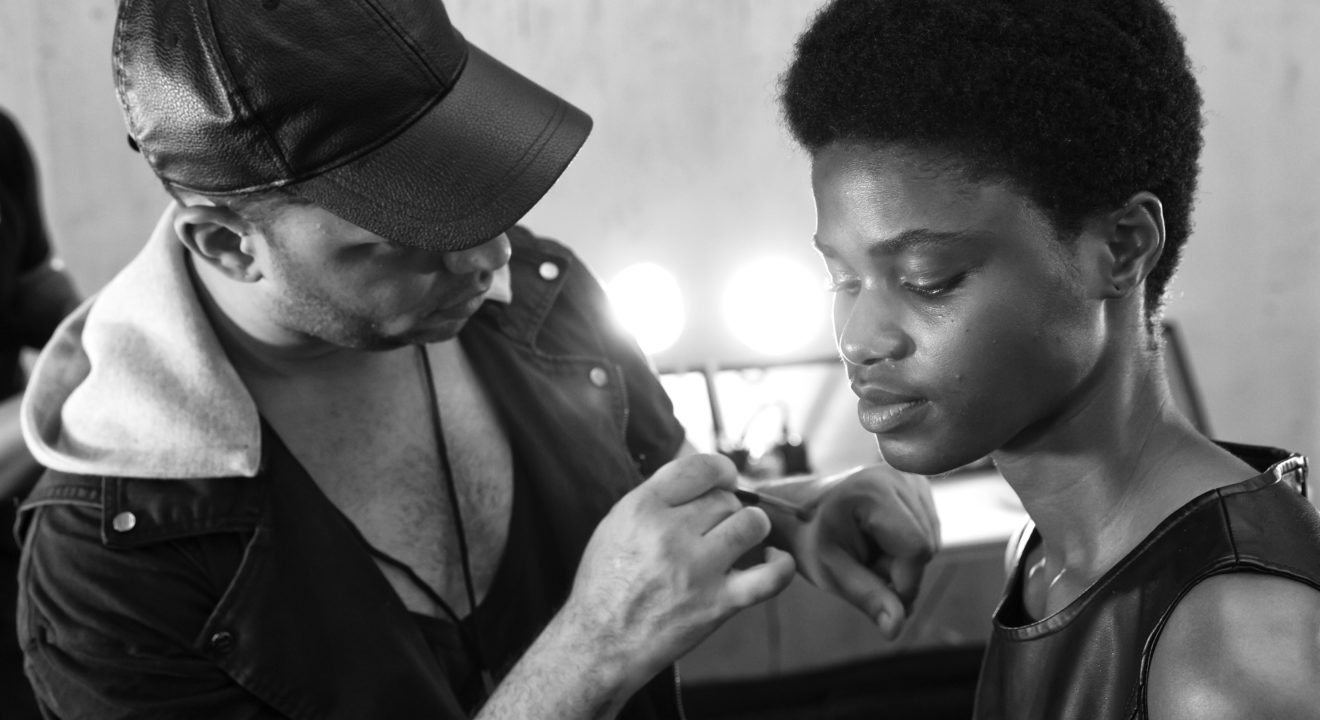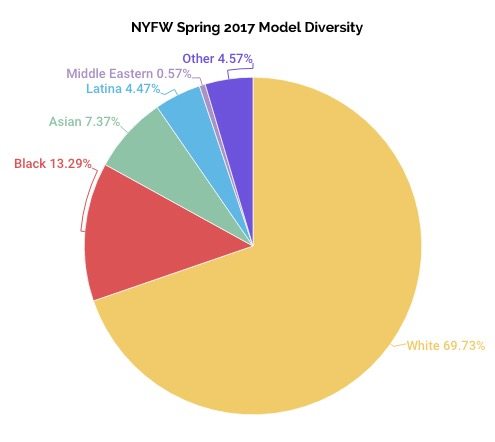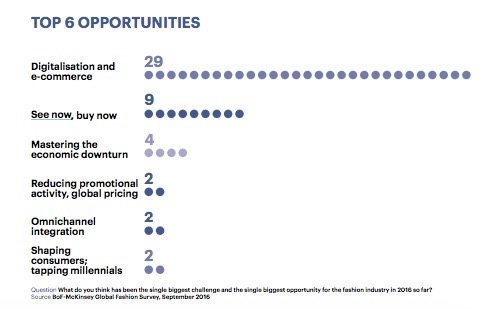Style February 3, 2017


Whether you’re reading a magazine, watching a commercial on TV or shopping at your favorite store at the mall, it’s impossible to ignore the advertisements staring back at you: gorgeous women, all fashionable, thin, young and white.
It’s no secret that, when describing the modeling world, “diverse” probably isn’t the first word that pops into your mind. However, that’s no excuse for the fact that we’ve reached 2017 – and we’re still seeing the same problems in the fashion industry: rows of models who look exactly the same.
So what is the state of diversity within fashion today? Why is it important to be able to see plus-size, older or minority models on billboards just as much as thin, young blondes? And what needs to happen for the entire fashion industry to change? ENTITY recently sat down with Susan Scafidi, founder and academic director of the Fashion Law Institute at Fordham University, to explore the ugly truths behind one of the world’ most beautiful occupations.
If you’ve ever watched “Project Runway,” “America’s Next Top Model” or the “Victoria’s Secret Fashion Show” for a few years, you might have noticed a little more diversity in models with every season. However, progress is a slow and unsteady process when it comes to increasing diversity in the fashion world – and Fashion Spot’s latest diversity analysis for Spring 2017’s New York Fashion Week doesn’t look promising. After tallying 110 shows, they discovered that 69.7 percent of the models were white, with only 30.3 percent being nonwhite. This is a step in the wrong direction considering 31.9 percent of Fall 2016’s models were nonwhite.


Chart from The Fashion Spot
Not only that, but the lines of big names like swimwear tycoon Zimmermann, Mary-Kate and Ashley Olsen and Nicole Miller all boasted less than 10 percent diversity. The number of models over 50 also fell from 11 to eight. However, before you start hating on all the NYFW designers, a few made admirable attempts to shake up the homogeneous fashion scene. Eight transgender models appeared and 16 plus-sized models ruled the runway.
These stats reflect Susan Scafidi’s belief that, out of all types of diversity (in size, age, race, etc), racial diversity has made the most progress. “Any fashion house that ignores racial diversity in casting will invoke the immediate ire of both traditional and social media,” she explains, “Size and age diversity, however, have received less attention, and overall diversity in editorial and in well-paid advertising campaigns is not as immediately quantifiable and thus can lag behind.”
In the fable of the tortoise and the hare, “slow and steady” may win the race. However, when it comes to increasing model diversity, progress seems to be dangerous slow … and even more dangerously inconsistent.
So what’s the big deal if you don’t see many skin tones besides ivory and sun-kissed on the runway? One of the negatively-impacted groups you may not initially think of are the minority models themselves. After all, if only 30 percent of NYFW models are nonwhite, that means there are only a fraction of the open spots for minorities. As Jenna Sauers from Jezebel points out, this lower amount of job opportunities causes “models of color to compete against each other” for the few nonwhite openings. Not only that, but it can also mean nonwhite models will work for less (because they want to work at all), earn less over their career and be less valued or sought after by agencies.
The challenges don’t stop even if you’re booked for a show. Nykhor Paul, a fashion model from South Sudan, went viral in 2015 for her Instagam post to “white people” – particularly makeup artists – in the fashion industry. “Why do I have to bring my own makeup to a professional show when all the other white girls don’t have to do anything but show up wtf!” she wrote. “Stop apologizing it’s insulting and disrespectful to me and my race it doesn’t help, seriously! Make an effort at least!”
Besides runways, models have also been looked over for advertising jobs, like when ABC and NBC “rejected” a 30-second commercial called “This Body” last year. The ad featured plus-sized models like Ashley Graham and it was viewed almost one million times by supporters. One model, Deddeh Howard, even recreated famous fashion campaigns to point out that “black girls are almost invisible” in the fashion industry and that “it is time for all of us [to be] seen.”
The truth is that diversity may be improving, but until a real difference is made, minority models – whether nonwhite, plus-size or older – have to work extra hard for the same opportunities.
It’s not just the models who are hurt by lack of diversity in the fashion field, however. Everyone who is exposed to advertisements, modeling shows and fashion magazines are experiencing their share of negative effects, too. As Susan Scafidi explains, “Fashion models are also role models, especially for young women. Industry affirmation that beauty comes in many colors, sizes, ages, abilities, etc. can promote confidence, positive self-image and the achievement that accompanies those attitudes.”
Models Clementine Desseaux and Charli Howard agree with Scafidi and the proof is in their joint project, the All Woman Project. “It’s like a campaign we’d dream of being featured in, but no brand would ever do. It’s just like a big ‘hello’ to the industry. We exist. We’re beautiful,” says Desseaux. “We just want all girls to look at their bodies and realize that there’s nothing wrong with them.”
Woman you don’t need permission to be all that you are. ♡ #iamallwoman #womanhood #modeling… https://t.co/PFSGgHPQ1q
— Jaz (@Jaz77) December 12, 2016
“Remember that beauty & happiness can’t be found externally, but only from within.” @allwomanproject #iamallwoman https://t.co/eFklhLWvZI pic.twitter.com/KLRJqsySEO
— Brittany Burgunder (@BrittBurgunder) November 16, 2016
#IamAllWoman pic.twitter.com/naoFlgI8sw
— All Woman (@AllWomanMin) January 17, 2017
Besides creating the campaign, the All Woman Project also filmed a video featuring body-positive models like Iskra Lawrence, Barbie Ferreira and Denise Bidot dancing around and making comments like, “It’s time that women start empowering each other, getting together and celebrating diversity.” The hashtag #IAmAllWoman took off from there.
Research shows that although 63 percent of girls think fashion models’ bodies are unrealistic, 60 percent still compare their bodies to those of fashion models, 48 percent wish they were as skinny as models and 31 percent admit to starving themselves to reach that ideal. We shouldn’t just increase diversity in modeling for the good of the models or even ourselves; we need to do it for the well-being of women outside the industry, as well.
For decades, the go-to excuse for lack of diversity on the runway has been, as supermodel Jourdan Dunn puts it, “If you have a black face on a magazine cover it won’t sell,” even though there’s no evidence of that. Hadley Freeman, writer at The Guardian, agrees, saying that the problem isn’t so much that designers want models who “look like them.” Instead, it’s that the fashion industry wants to follow the money, and doesn’t envision minorities buying their high class clothes.
Yazemeenah Rossi proves that age is just a number #diversity #ageism #creativeindustries https://t.co/o5XiRjdJ2u
— CreativeConversation (@CreativConvers) January 17, 2017
.@RyersonU thank you for being a leader by including more diversity in your advertising including plus size bodies #plussize pic.twitter.com/szurgKutjQ
— Krista Henderson (@kristahenderson) January 10, 2017
The community wants to see diversity in advertising, including people with disabilities, reflecting the real world https://t.co/xrur3lrDD5
— Attitude Foundation (@Ausattitude) January 24, 2017
Recent research, however, shows that the fashion industry is following the wrong trail of breadcrumbs if they’re looking for a big payday. A study by Dr. Ben Berry of Ryserson University recently found that, when focus groups were shown ads with white or black models, black women were 1.5 times more likely to buy from companies featuring black models. Not only that, but white customers’ shopping preferences didn’t change regardless of the race of the model. For black women, seeing a black model made them feel “inspired to celebrate their beauty by shopping from that brand.” For white women, companies featuring black women seemed to portray their values of empowerment and inclusion. Not only do customers want diversity in advertising, but they’ll put their money where their values are!
The growing trend of “see now, buy now” fashion runways may also benefit both models and designers’ bottom lines. According to The Business of Fashion’s 2017 report, “see now, buy now” was viewed as the biggest opportunity of 2016 by nine fashion executives. For diversity proponents, this is great news. “The nascent see-now-buy-now fashion week experiments may solve a longstanding problem: runway samples available in only one (very small) size,” says Susan Scafidi. “If a fashion house is prepared to sell at least some items of clothing to consumers immediately upon showing them, as opposed to six months later, then clearly those items are available in multiple sizes for the runway as well.”


Chart in the Business of Fashion’s 2017 Trends Report
Sure, maybe your major motivation in supporting greater model diversity is to help girls’ body image and let you see your version of “beautiful” on the runway. However, diversity also seems to be an easy (and empowering) way for businesses to boost their own bottom lines.
So what needs to happen for real change to hit the runway? If you’re thinking we need to start petitioning congressmen for new laws dedicated to modeling diversity, you need to go back to square one. Because models are considered independent contractors, they aren’t covered by most labor and anti-discrimination laws. Also, although the Civil Rights Act prohibits discrimination in employment based on race, color, or ethnic origin, people are hired in the fashion industry, well, for their looks. For Sarah Ziff, president of Models Alliance, “even if it is not illegal to discriminate against models who are minorities, it’s socially unacceptable.”
What this means is that it is up to us – the public, which help define what is “socially acceptable” – to do our parts to promote modeling diversity. This can involve anything from boycotting brands who don’t include models of different races or ages in their advertising to getting involved in a social media movement.
It won’t be easy, but the key is “collaborative effort, including agencies who recruit and represent models, casting directors, designers, fashion editors and critics and consumers,” says Susan Scafidi. “Until diversity becomes simply business – or beauty – as usual, a lack of commitment at any point in the system can lead to a lack of diversity.”
Nowadays, it may seem like you can’t go thirty minutes without seeing a model staring back at you from a magazine, the side of a bus or a TV commercial. You may not even realize that most of those beautiful women on TV have the similar traits in terms of race, age and size. However, as much progress as we have made in other areas of society – from women’s rights to awareness of mental health struggles to LGBTQ acceptance – we still have a lot of work do to in the realm of modeling diversity.
professional goal this year: get my company to book an Asian model for a photo shoot. I’m truly tired of the lack of diversity in fashion.
— Xtine (@christinentran) January 6, 2017
Because until all models can be considered beautiful, the modeling world is a pretty ugly place.